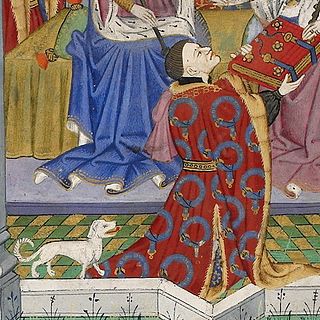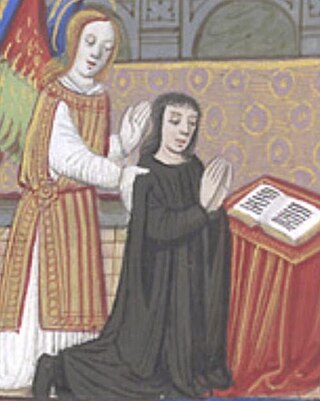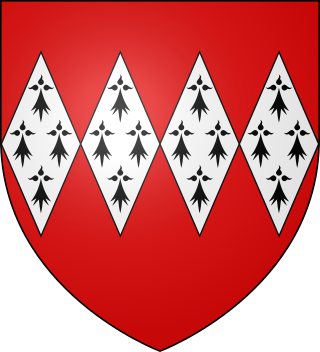Related Research Articles

John Howard, 1st Duke of Norfolk, also known as Jack of Norfolk,, was an English nobleman, soldier, politician, and the first Howard Duke of Norfolk. He was a close friend and loyal supporter of King Richard III, with whom he was slain at the Battle of Bosworth in 1485.

Ralph Neville, 1st Earl of WestmorlandEarl Marshal, was an English nobleman of the House of Neville.

John Talbot, 1st Earl of Shrewsbury, 1st Earl of Waterford, 7th Baron Talbot, KG, known as "Old Talbot", was an English nobleman and a noted military commander during the Hundred Years' War. He was the most renowned in England and most feared in France of the English captains in the last stages of the conflict. Known as a tough, cruel, and quarrelsome man, Talbot distinguished himself militarily in a time of decline for the English. Called the "English Achilles" and the "Terror of the French", he is lavishly praised in the plays of Shakespeare. The manner of his death, leading an ill-advised charge against field artillery, has come to symbolize the passing of the age of chivalry. He also held the subsidiary titles of 10th Baron Strange of Blackmere and 6th Baron Furnivalljure uxoris.
Baron Chaworth is a title that has been created three times, once in the Peerage of England, once in the Peerage of Ireland, and once in the Peerage of the United Kingdom.
Sir James OrmondaliasButler was the son of John Butler, 6th Earl of Ormond. He was Lord Treasurer of Ireland from 1492 to 1494, and helped to defend the Lordship of Ireland against the forces of Perkin Warbeck. He was murdered by Sir Piers Butler on 17 July 1497. Piers would later hold the title of Earl of Ormond.

John Talbot was the 2nd Earl of Shrewsbury, 2nd Earl of Waterford, 8th Baron Talbot, KG was an English nobleman and soldier and the son of John Talbot, 1st Earl of Shrewsbury, 1st Earl of Waterford, 7th Baron Talbot, 10th Baron Strange of Blackmere, and Maud Neville, 6th Baroness Furnivall.

Thomas Butler, 7th Earl of Ormond PC was the youngest son of James Butler, 4th Earl of Ormond. He was attainted, but restored by Henry VII's first Parliament in November 1485, and the statutes made at Westminster, by Edward IV, which declared him and his brothers traitors, were abrogated.
John Butler, 6th Earl of Ormond was considered one of the first gentlemen of the age in which he lived. He was an ambassador to the most important courts of Europe.

William de Beauchamp, 1st Baron Bergavenny, KG was an English peer.
Robert Radcliffe, 10th Baron Fitzwalter, 1st Earl of Sussex, KG, KB, PC, also spelt Radclyffe, Ratcliffe, Ratcliff, etc., was a prominent courtier and soldier during the reigns of Henry VII and Henry VIII, who served as Chamberlain of the Exchequer and Lord Great Chamberlain.

Fulk Bourchier, 10th Baron FitzWarin was the son and heir of William Bourchier, 9th Baron FitzWarin (1407–1470) and the father of John Bourchier, 1st Earl of Bath. He was feudal baron of Bampton in Devon.
The Sheriff of Nottinghamshire, Derbyshire and the Royal Forests is a position established by the Normans in England.
John Blount, 3rd Baron Mountjoy was an English peer and soldier.

John Dynham, 1st Baron Dynham, KG of Nutwell in the parish of Woodbury and of Hartland, both in Devon, was an English peer and politician. He served as Lord High Treasurer of England and Lord Chancellor of Ireland. He was one of the few men to have served as councillor to Kings Edward IV, Richard III and Henry VII and was trusted by all of them.

Sir Thomas Brandon, of Southwark, Surrey, and of Duddington, Northamptonshire, KG was an English soldier, courtier and diplomat.
Sir William Fitzwilliam was a Merchant Taylor, Sheriff of London, servant of Cardinal Wolsey, and a member of the council of Henry VII.
Elizabeth Bourchier was an English noblewoman. She was, by her third husband, Sir Edward Stanhope, the mother of Anne Stanhope, wife of the Protector Somerset. Her fourth husband was the courtier Sir Richard Page. She died in 1557, and was buried at Clerkenwell.
Sir Richard Hastings, Baron Welles, was the son of Sir Leonard Hastings and a younger brother of William Hastings, 1st Baron Hastings. He was a favourite of Edward IV, who granted him the lands of the baronies of Willoughby and Welles after he had married the heiress, Joan Welles. He fought at Tewkesbury. He died in 1503, and was buried at the Greyfriars, London.
Bridget Chaworth, later Bridget Carr, was a gentlewoman of the Privy Chamber to Elizabeth I and Queen Anne.

Mohuns Ottery or Mohun's Ottery, is a house and historic manor in the parish of Luppitt, 1 mile south-east of the village of Luppitt and 4 miles north-east of Honiton in east Devon, England. From the 14th to the 16th centuries it was a seat of the Carew family. Several manorial court rolls survive at the Somerset Heritage Centre, Taunton, Somerset.
References
- Cokayne, George Edward (1913). The Complete Peerage, edited by Vicary Gibbs. Vol. III. London: St Catherine Press. pp. 153–4.
- Hicks, Michael (2004). "Dynham, John, Baron Dynham (c.1433–1501)". Oxford Dictionary of National Biography (online ed.). Oxford University Press. doi:10.1093/ref:odnb/50234.(Subscription or UK public library membership required.)
- Lysons, Daniel and Samuel Lysons (1817). Magna Britannia. Vol. V. London: T. Cadell and W. Davies. Retrieved 12 December 2013.
- Payling, S.J. (2004). "Chaworth family (per. c. 1160–c. 1521)". Oxford Dictionary of National Biography (online ed.). Oxford University Press. doi:10.1093/ref:odnb/52780.(Subscription or UK public library membership required.)
- Richardson, Douglas (2011). Everingham, Kimball G. (ed.). Magna Carta Ancestry: A Study in Colonial and Medieval Families. Vol. I (2nd ed.). Salt Lake City. p. 382. ISBN 978-1449966379.
{{cite book}}: CS1 maint: location missing publisher (link) - Pollard, A.J. (2004). "Talbot, John, second earl of Shrewsbury and second earl of Waterford (c.1413–1460)". Oxford Dictionary of National Biography (online ed.). Oxford University Press. doi:10.1093/ref:odnb/26933.(Subscription or UK public library membership required.)